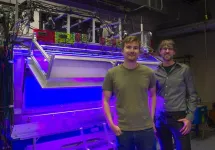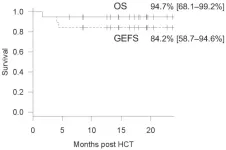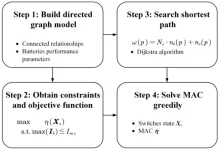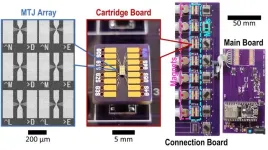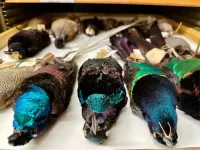(Press-News.org) RENO, Nevada — Why do flies buzz around in circles when the air is still? And why does it matter?
In a paper published online July 26, 2024 by the scientific journal Current Biology, University of Nevada, Reno Assistant Professor Floris van Breugel and Postdoctoral Researcher S. David Stupski respond to this up-until-now unanswered question. And that answer could hold a key to public safety — specifically, how to better train robotic systems to track chemical leaks.
“We don’t currently have robotic systems to track odor or chemical plumes,” van Breugel said. “We don’t know how to efficiently find the source of a wind-borne chemical. But insects are remarkably good at tracking chemical plumes, and if we really understood how they do it, maybe we could train inexpensive drones to use a similar process to find the source of chemicals and chemical leaks.”
A fundamental challenge in understanding how insects track chemical plumes — basically, how does the fly find the banana in your kitchen? — is that wind and odors can’t be independently manipulated.
To address this challenge, van Breugel and Stupski used a new approach that makes it possible to remotely control neurons—specifically the “smell” neurons— on the antennae of flying fruit flies by genetically introducing light-sensitive proteins, an approach called optogenetics. These experiments, part of a $450,000 project funded through the Air Force Office of Scientific Research, made it possible to give flies identical virtual smell experiences in different wind conditions.
What van Breugel and Stupski wanted to know: how do flies find an odor when there’s no wind to carry it? This is, after all, likely the wind experience of a fly looking for a banana in your kitchen. The answer is in the Current Biology article, “Wind Gates Olfaction Driven Search States in Free Flight.” The print version will appear in the Sept. 9 issue.
Flies use environmental cues to detect and respond to air currents and wind direction to find their food sources, according to van Breugel. In the presence of wind, those cues trigger an automatic “cast and surge” behavior, in which the fly surges into the wind after encountering a chemical plume (indicating food) and then casts — moves side to side — when it loses the scent. Cast-and-surge behavior long has been understood by scientists but, according to van Breugel, it was fundamentally unknown how insects searched for a scent in still air.
Through their work, van Breugel and Stupski uncovered another automatic behavior, sink and circle, which involves lowering altitude and repetitive, rapid turns in a consistent direction. Flies perform this innate movement consistently and repetitively, even more so than cast-and-surge behavior.
According to van Breugel, the most exciting aspect of this discovery is that it shows flying flies are clearly able to assess the conditions of the wind—its presence, and direction—before deploying a strategy that works well under these conditions. The fact that they can do this is actually quite surprising—can you tell if there is a gentle breeze if you stick your head out of the window of a moving car? Flies aren’t just reacting to an odor with the same preprogrammed response every time like a simple robot, they are responding in context-appropriate manner. This knowledge potentially could be applied to train more sophisticated algorithms for scent-detecting drones to find the source of chemical leaks.
So, the next time you try to swat a fly in your home, consider the fact that flies might actually be a little more aware of some of their natural surroundings than you are. And maybe just open a window to let it out.
END
New understanding of fly behavior has potential application in robotics, public safety
Mechanical Engineering professor publishes findings in Current Biology
2024-07-26
ELSE PRESS RELEASES FROM THIS DATE:
Investigating the effect of alemtuzumab in allogeneic hematopoietic cell transplantation in patients with inborn errors of immunity
2024-07-26
Researchers from Tokyo Medical and Dental University (TMDU) explore the safety and effectiveness of alemtuzumab in an Asian cohort
Tokyo, Japan – Allogeneic hematopoietic cell transplantation (HCT) is a commonly used curative therapy for individuals with inborn errors of immunity (IEI). HCT involves introducing stem cells from a compatible donor with the aim of replacing the affected cells in the recipient’s body. Reduced-toxicity conditioning (RTC) is an approach for reducing drug-related toxicities post HCT in patients with IEIs. Alemtuzumab is a humanized anti-CD52 monoclonal antibody that strongly ...
Determining maximum allowable current of an RBS using a directed graph model and greedy algorithm
2024-07-26
The central principle of the proposed MAC determination method is to connect the batteries within an RBS in parallel to the maximum possible extent, thereby maximizing the output current. To achieve this universally and automatically, the overall process is divided into the 4 steps shown in Fig. 1. First, a directed graph model is established for the subsequent computations. The nodes in the directed graph correspond to the connection points of components in the actual RBS. The edges in the directed graph correspond to the batteries, switches, and external electrical loads in the actual ...
Developed a 21-language, fast and high-fidelity neural text-to-speech technology that works on smartphones
2024-07-26
Highlights
-Developed a 21-language, fast and high-fidelity neural text-to-speech technology
-The developed model can synthesize one second of speech at high speed in only 0.1 seconds using a single CPU core, which is about eight times faster than the conventional methods
-The developed model can realize fast synthesis with a latency of 0.5 seconds on a smartphone without network connection
-The technology is expected to be introduced into speech applications, such as multilingual speech translation and car navigation
Abstract
The Universal Communication Research Institute of the National Institute of Information and Communications Technology (NICT, President: TOKUDA Hideyuki, ...
Supporting school re-entry of children with special health care needs post extended hospitalizations
2024-07-26
East Hanover, NJ – July 26, 2024 – Children with special health care needs (CSHCN) often face significant disruptions in their education due to extended hospitalizations. A recent study published online in Disability and Rehabilitation on July 1, 2024, by a multidisciplinary team of Kessler Foundation and Children Specialized Hospital researchers, highlights critical areas needing attention to ensure smoother school re-entries for CSHCN, ensuring they receive the necessary educational support post-hospitalization.
Involving parents, former patients, and rehabilitation ...
Have a seat, doctor: Study suggests eye-level connection makes a difference in hospitals
2024-07-26
Doctors and others who take care of hospitalized patients may want to sit down for this piece of news.
A new study suggests that getting at a patient’s eye level when talking with them about their diagnosis or care can really make a difference. Sitting or crouching at a hospitalized patient’s bedside was associated with more trust, satisfaction and even better clinical outcomes than standing, according to the new review of evidence.
The study’s authors, from the University of Michigan and VA Ann Arbor Healthcare System, note that most of the studies on this topic varied with their interventions and outcomes, and were found to have high risk of bias. Their ...
BRCA1/2: Why men should be screened for the ‘breast cancer gene’
2024-07-26
More and more studies show that men face risks of cancer from BRCA1 and BRCA2 genetic mutations that are most often associated with breast and ovarian cancers in women.
According to a July 25 JAMA Oncology review article by experts at Fred Hutch Cancer Center and University of Washington, newly developed national screening guidelines offer hope for identifying the cancer risk of BRCA mutations in men through genetic testing and tailored cancer screening.
“Not enough men are getting genetic testing to see if they carry a BRCA1 or BRCA2 gene ...
Researchers develop state-of-the-art device to make artificial intelligence more energy efficient
2024-07-26
MINNEAPOLIS / ST. PAUL (07/25/2024) — Engineering researchers at the University of Minnesota Twin Cities have demonstrated a state-of-the-art hardware device that could reduce energy consumption for artificial intelligent (AI) computing applications by a factor of at least 1,000.
The research is published in npj Unconventional Computing, a peer-reviewed scientific journal published by Nature. The researchers have multiple patents on the technology used in the device.
With the growing demand of AI applications, researchers have been looking ...
The Texas Heart Institute provides BiVACOR® Total Artificial Heart Patient update
2024-07-26
Houston, Texas, July 26, 2024 – The Texas Heart Institute (THI), a globally renowned cardiovascular health center, and BiVACOR®, a leading clinical-stage medical device company, are pleased to provide an update on the condition of the first patient to receive the BiVACOR Total Artificial Heart (TAH) implant on July 9, as part of the U.S. Food and Drug Administration (FDA) Early Feasibility Study (EFS). On July 17, eight days following the BiVACOR TAH implant, a donor heart became available and was transplanted into the ...
The ancestor of all modern birds probably had iridescent feathers
2024-07-26
The color palette of the birds you see out your window depend on where you live. If you’re far from the Equator, most birds tend to have drab colors, but the closer you are to the tropics, you’ll probably see more and more colorful feathers. Scientists have long been puzzled about why there are more brilliantly-colored birds in the tropics than in other places, and they’ve also wondered how those brightly-colored birds got there in the first place: that is, if those colorful feathers evolved in the tropics, or if tropical birds have colorful ancestors that came to the region from somewhere else. In a new study published ...
A rare form of ice at the center of a cool new discovery about how water droplets freeze
2024-07-26
Tokyo, Japan – Ice is far more complicated than most of us realize, with over 20 different varieties known to science, forming under various combinations of pressure and temperature. The kind we use to chill our drinks is known as ice I, and it’s one of the few forms of ice that exist naturally on Earth. Researchers from Japan have recently discovered another type of ice: ice 0, an unusual form of ice that can seed the formation of ice crystals in supercooled water.
The formation of ice near the surface ...
LAST 30 PRESS RELEASES:
Heart-brain connection: international study reveals the role of the vagus nerve in keeping the heart young
Researchers identify Rb1 as a predictive biomarker for a new therapeutic strategy in some breast cancers
Survey reveals ethical gaps slowing AI adoption in pediatric surgery
Stimulant ADHD medications work differently than thought
AI overestimates how smart people are, according to HSE economists
HSE researchers create genome-wide map of quadruplexes
Scientists boost cell "powerhouses" to burn more calories
Automatic label checking: The missing step in making reliable medical AI
Low daily alcohol intake linked to 50% heightened mouth cancer risk in India
American Meteorological Society announces Rick Spinrad as 2026 President-Elect
Biomass-based carbon capture spotlighted in newly released global climate webinar recording
Illuminating invisible nano pollutants: advanced bioimaging tracks the full journey of emerging nanoscale contaminants in living systems
How does age affect recovery from spinal cord injury?
Novel AI tool offers prognosis for patients with head and neck cancer
Fathers’ microplastic exposure tied to their children’s metabolic problems
Research validates laboratory model for studying high-grade serous ovarian cancer
SIR 2026 delivers transformative breakthroughs in minimally invasive medicine to improve patient care
Stem Cell Reports most downloaded papers of 2025 highlight the breadth and impact of stem cell research
Oxford-led study estimates NHS spends around 3% of its primary and secondary care budget on the health impacts of heat and cold in England
A researcher’s long quest leads to a smart composite breakthrough
Urban wild bees act as “microbial sensors” of city health.
New study finds where you live affects recovery after a hip fracture
Forecasting the impact of fully automated vehicle adoption on US road traffic injuries
Alcohol-related hospitalizations from 2016 to 2022
Semaglutide and hospitalizations in patients with obesity and established cardiovascular disease
Researchers ‘listen in’ to embryo-mother interactions during implantation using a culture system replicating the womb lining
How changing your diet could help save the world
How to make AI truly scalable and reliable for real-time traffic assignment?
Beyond fragmented markets: A new framework for efficient and stable ride-pooling
Can shape priors make road perception more reliable for autonomous driving?
[Press-News.org] New understanding of fly behavior has potential application in robotics, public safetyMechanical Engineering professor publishes findings in Current Biology
